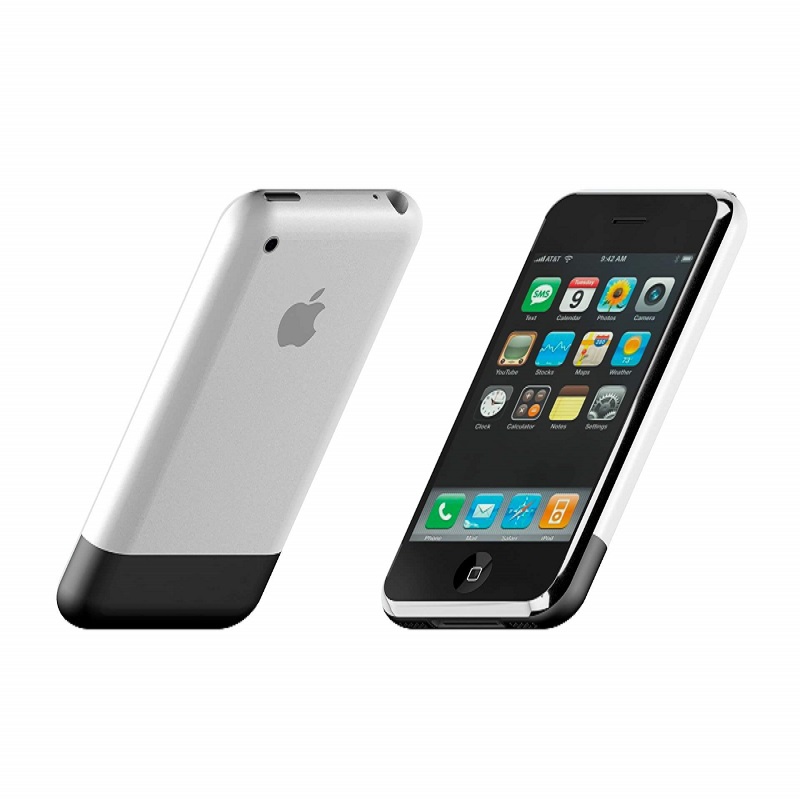In the history of technology, some inventions stand tall as landmarks! be it the television in the mid-20th century or the personal computer in the late ’70s. By 2007, another addition was about to be etched into this list: Apple’s iPhone 2G. Its launch reshaped the mobile device landscape, turning smartphones from a luxury to a necessity.
Before the debut of the iPhone 2G, the realm of mobile devices was fragmented, with a clear distinction between cell phones and PDAs. The smartphone wasn’t a daily part of our lives. But by 2007, the phone game was on a path of no return. Apple was about to break the dam. They were known for their commitment to innovation and technology, but this one was going to be big. A device that would bridge the digital divide and change how we interact with tech.
A Historical Perspective: The World Before iPhone 2G
Before the iPhone’s introduction, brands like Nokia, Sony, LG, BlackBerry, and Motorola dominated the mobile phone industry. Whether BlackBerry’s efficient email services or Nokia’s robust build, these phones had their strengths. Yet, none combined aesthetics, usability, and functionality in a way that was accessible to the everyday user. Internet on these devices could have been clearer, with WAP browsers that offered a severely limited web experience. Apps, as we know them today, were mainly non-existent, replaced instead by essential built-in software and games.
The Grand Unveiling: Release of iPhone 2G
Apple’s announcement events have always been a spectacle, but none can rival the sheer impact of the iPhone 2 G’s unveiling. On January 9, 2007, Steve Jobs, Apple’s iconic co-founder, confidently took the stage to introduce what he described as a “revolutionary product.” With palpable excitement, he explained that this wasn’t just one product but three: “An iPod, a phone, and an internet communication device.”

Source: renderhub.com
The world watched in awe as he delved into its design, features, and the magic behind it all. The anticipation was at a fever pitch by the time June rolled around. Apple didn’t just release a product; they unleashed a phenomenon.
On its first day of sale, the scene outside Apple Stores was a testament to the iPhone’s allure. Thousands, from tech enthusiasts to everyday consumers, queued up, some camping out overnight to be among the first to own this game-changing device.
The sales figures spoke to the iPhone’s immediate success. During the first 30 hours of Apple’s iPhone release, they managed to sell around 270,000 phones. For a company new to the mobile phone market that’s a staggering amount. But by the end of 2007, it was supercharged to almost 1.4 million. It wasn’t just a phone, it was a status symbol and a signal to where technology was headed. The first iPhone also known as the iPhone 2G wasn’t just its own release. It marked Apple’s breakthrough into the mobile market and sparked a new era for smartphones.
“I remember standing in line for hours, just hoping to get one on the first day. The excitement was palpable; everyone knew this was going to be big,” recalls Jake Thompson, one of the early adopters.
Technical Mastery: Specifications and Features
- Display:
A 3.5-inch display with multi-touch support, allowing pinch-to-zoom functionality, a novelty at the time.
- Storage:
Available in 4GB and 8GB variants.
- Camera:
A 2-megapixel camera, which, despite lacking features like video recording, provided clear and vibrant photos.
- Processor:
Powered by a 412 MHz ARM 11 processor and 128 MB of RAM, offering a smooth user experience.
- Battery Life:
Up to 8 hours of talk time, is a significant achievement considering the device’s capabilities.
Compared to its contemporaries, the iPhone 2G was a marvel. Its processor was one of the most robust for mobile devices, and while other phones had cameras, the clarity and color richness from the iPhone 2G’s 2MP lens was notable.
The Birth of iOS: A Paradigm Shift
When the iPhone 2G was unveiled, it came with an equally groundbreaking software: iPhone OS 1, later renamed iOS. This operating system, while in its infancy, signaled the beginning of a major paradigm shift in mobile technology and user experience.
iPhone OS 1’s debut came with a suite of features that would shape the smartphone landscape:
- Visual Voicemail:
A feature that disrupted traditional voicemail services by allowing users to view a list of their voicemails and select which ones to listen to, and in any order.
- Multi-touch Gestures:
This changed the way we interacted with screens, introducing intuitive gestures like pinch-to-zoom and swipe-to-navigate.
- HTML Email and Safari:
Browsing became a smoother experience with Apple’s Safari web browser and the ability to view rich HTML emails.
- Threaded Text Messaging:
A new, organized way to view conversations, making it easier to follow discussions.
- Integrated Apps:
iPhone OS 1 brought a collection of essential apps, from the “iPod” music and video player, a dedicated YouTube app, and the Google Maps-powered Maps app to basic utilities like Phone/contacts, Calendar, Photos, Stocks, Weather, Clock, Calculator, Notes, and Settings.
Yet, it could have been better. The initial release lacked features many took for granted on other devices. MMS, third-party apps, and simple copy-and-paste functions were conspicuously missing. This gap in functionality led many tech enthusiasts to “jailbreak” their devices, effectively unlocking the operating system to allow unauthorized functionalities and apps.
Recognizing the users’ demands, Apple embarked on continuous software improvements. With each subsequent update, they introduced functionalities that the users craved, eventually making jailbreaking less attractive for most.
The Birth of iOS was more than just a software launch; it was the genesis of an ecosystem. An ecosystem that, today, has grown exponentially in size, capability, and influence, redefining the boundaries of what’s possible on a mobile device.
Pricing Evolution: From Launch to Now
The iPhone 2 G’s price was a hot topic. At first, the 4GB iPhone cost $499, while the 8GB one was $599. This was with a 2-year agreement with AT&T. Then, after a few months, Apple stopped making the 4GB model. The price of the 8GB model fell to $399. This upset folks who bought one early on.
Now, the iPhone 2G is a sought-after collectible. If it’s in perfect shape, it can sell for $1,000 to $10,000. It’s especially valuable if it’s still in its unopened box.
Post-release Dynamics: Making Waves in the Tech World
Amidst the widespread acclaim, Apple also faced hurdles. Critics pointed at the iPhone’s on-screen keyboard, questioning its efficiency. Another sticking point was the lack of 3G capabilities in a growing 3G market. But Apple, known for its relentless pursuit of perfection, took this feedback seriously. Subsequent versions saw massive improvements, and the company’s dedication to refining its product ensured the iPhone’s position at the top.
Comparing Titans: iPhone 2G Vs. Contemporary Smartphones
When stacking up against contemporaries, the iPhone 2G held its ground remarkably well. BlackBerry dominated the corporate world with its email services, and Nokia’s diverse range catered to almost every population segment. But Apple’s holistic approach, prioritizing not just features but the entire user experience, made the iPhone 2G stand out.
Conclusion: The Legacy of the iPhone 2G
The iPhone 2 G’s legacy can be seen in every subsequent iPhone. Apple’s commitment to user experience, innovation, and design began with the iPhone 2G. As we switch between apps, FaceTime with loved ones, or use our phones to control our homes, it’s essential to remember the device that laid the foundation for this digital age – the iPhone 2G.
